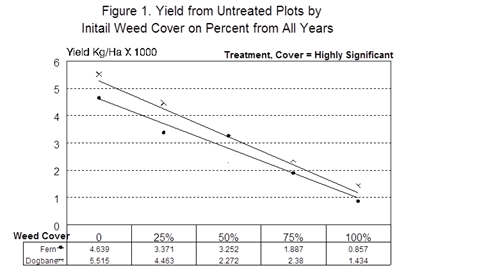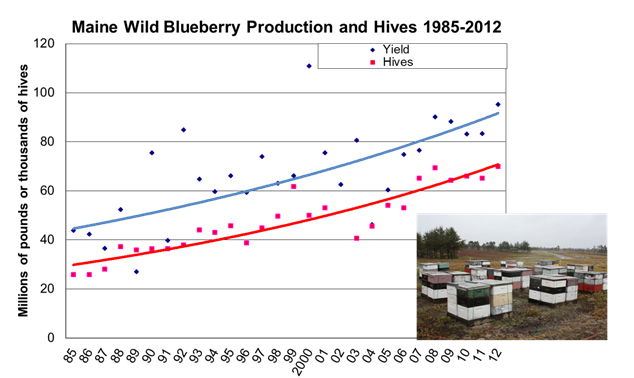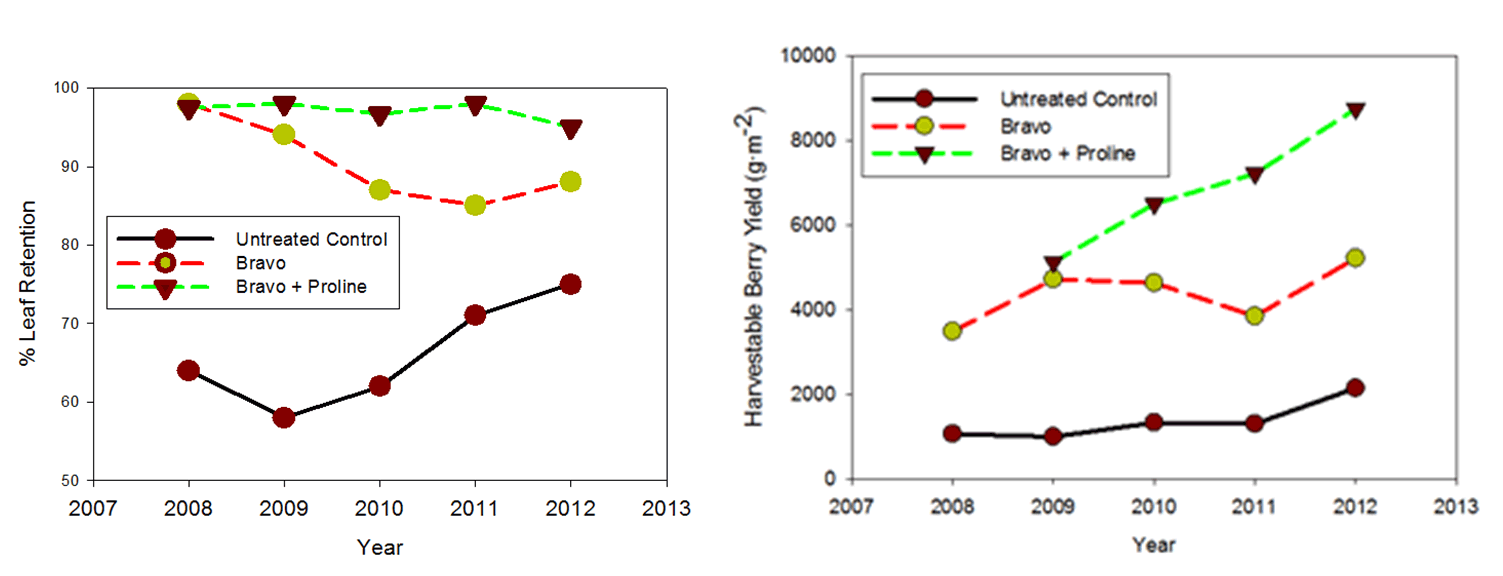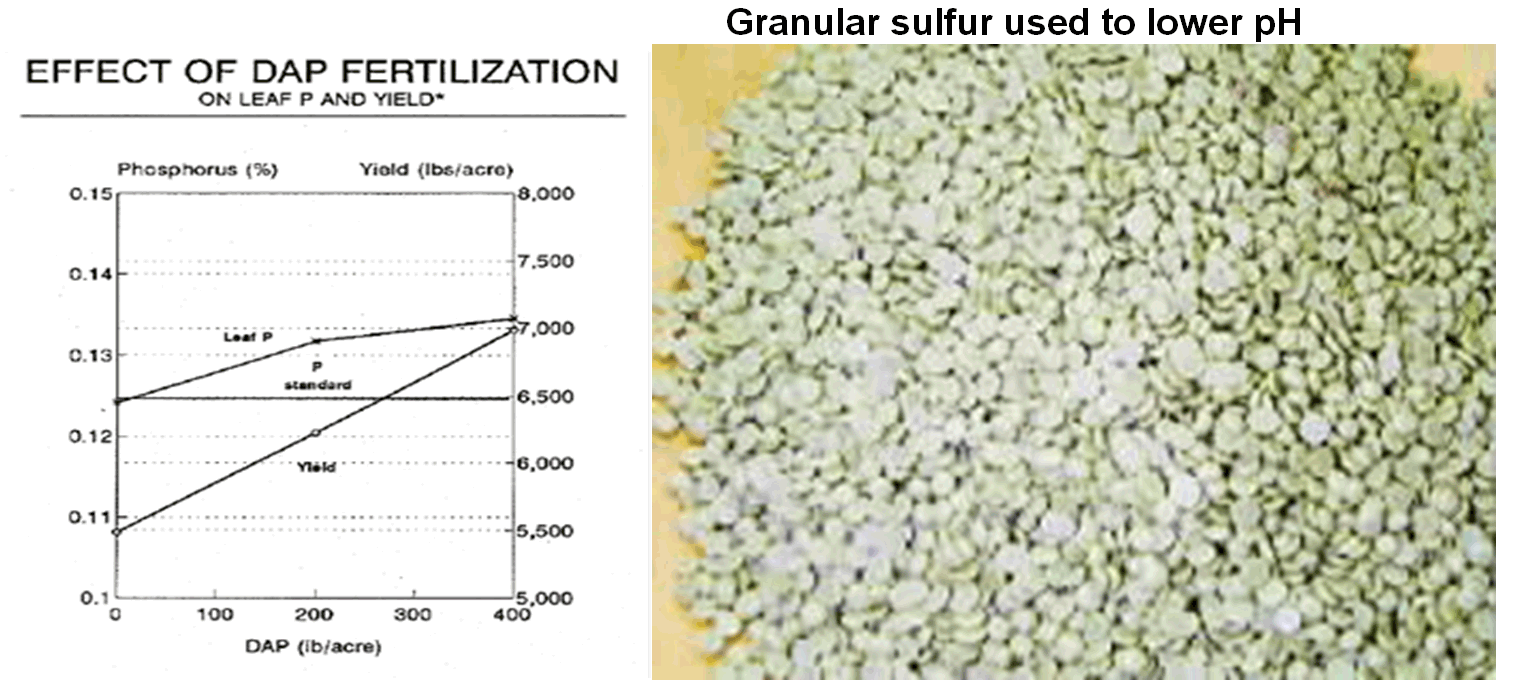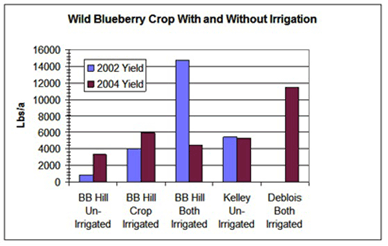Improving Your Wild Blueberry Yields
Prepared by David E. Yarborough, Extension Blueberry Specialist, The University of Maine, Orono, ME 04469. November 2012. Revised March 2013.
In February 2000, Researchers presented a talk at the spring meetings, entitled “You can get here from there or what does it take to get 10,000 pounds per acre on your blueberry field”. It was one of the best-attended sessions we had and although all fields may not be capable of this, many are and there are some now that have exceeded 10,000 pounds per acre. In this fact sheet, I will discuss the importance of these inputs to obtain higher yields.
Importance of Proper Pruning
Wild blueberries need to be pruned to promote new growth and pruning every other year will produce the highest yields. Burning was traditionally the practice used to prune wild blueberry fields but University of Maine researcher Moody Trevett in the 1950’s observed that hard burning was injuring wild blueberry rhizomes resulting in shrinking plants and reducing yields. Because of the cost of oil, most growers have converted to mowing to prune their fields when research done in the 1970’s showed that cutting the stems to within one inch of the soil could give the same yields as burning. In discussions with some growers, they indicated they did not think that the height of pruning was all that important, but research shows if pruning is done above one inch then significant reductions, going from 8000 lb/a to 6,000 lb/a, in your wild blueberry crop would result (see graph).
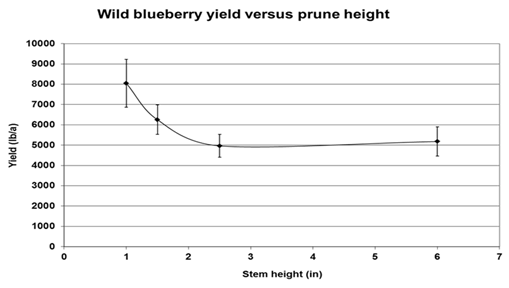
Early Pruning Will Reduce Yields Over Time
Pruning may also be used as a cultural pest management tool; thrips or tipworm curls may be mowed or burned to disrupt their cycles and thus prevent further spread. Valdensinia disease also may be controlled by spot burning to prevent the spread of this disease in your field. For more details, visit the Valdensinia Leaf-spot Disease Fact Sheet page.
Recent research indicates on average you could expect a 20% decline in buds if you prune by May 1 and a 50% decline by July 1 progressing to 100% reduction by the end of July. In the case of Valdensinia you will get a 100% yield loss, so it is important to eradicate this disease early to prevent it from getting established in your field. This short-term loss is a good investment in maintaining your future production.
Importance of Proper Weed Control
A wide variety of woody and herbaceous species native to Maine occur naturally in Maine’s wild blueberry fields. Any plant in a field other than a wild blueberry plant is considered a weed. The wild blueberry competes with weed species for space, water, and nutrients. This competition usually results in a reduction in crop yields and prevents the blueberry from spreading. The figure below shows the reduction in blueberry yield from over 5,000 lb/a to 1,000 lb/a as the weed cover is increased from zero to 100% over shading the blueberries. Weeds may also contribute distasteful fruit such as bunchberries and chokeberries, which reduce the quality of the processed pack and hinder harvest. Weeds also reduce the quality of the fruit by crushing and cutting of the fruit when harvested. Use of both herbicides and cultural tools such as the use of sulfur to reduce the soil pH and weed competition which reduces the need for herbicides, cutting woody weeds and applying mulch to encourage spread are all needed to be successful in managing weed competition. See the Wild Blueberry Fact Sheet No. 254, Cultural Management pH.
If weeds are not controlled first, then the benefits of fertilizer, pollination, and irrigation will not be fully realized. In the past, a single pre-emergence application of Velpar could control most weeds but as it has been used over 30 years, resistance has developed and now rotation or combining of other herbicides with different modes of action are needed to get good control. The 2016 Maine Wild Blueberry Pesticide Chart, Herbicides (PDF) has identified the group numbers of the herbicides registered. It is necessary to use combinations of different groups to maintain good control.
Successful weed management requires the integrated use of chemical and cultural methods. Knowing the weeds present, the proper method and timing of controls, and following labeled herbicide rates will decrease weed competition and increase the productivity of your field. Successful weed management does not mean a completely weed-free field but to get adequate weed suppression to increase blueberry yields and maximize your returns. A higher rate of an herbicide would produce a cleaner field, but may not result in higher yields. If the rate is too high, it may actually result in a decreased blueberry yield from injury to the blueberries. Concentrating efforts on fast-spreading weeds and those that are highly competitive will produce the highest return for efforts expended. More details may be found on the Wild Blueberry Fact Sheet No. 236, Weed Management in Wild Blueberry Fields.
Importance of Mummy Berry Blight Scouting
Mummy berry disease can cause serious loss of yield by blighting the stems, by the time you see the damage it is too late for control, so if you had this disease in the past then protective treatments need to be applied to prevent injury. See the Wild Blueberry Fact Sheet No. 217, A Method to Control Monilinia Blight.
Information on the progress of the disease and treatment timings may be found on the Wild Blueberry Blog page.
Putting out mummy berries in your field will allow you to more accurately monitor this disease in your own field and reduce the number of fungicide sprays needed. This method is illustrated in a PDF on the wild blueberry website that details the Mummy berry Disease Forecasting Method. Visit the Mummy berry Disease Fact Sheet.
Once a bloom occurs, you scout your fields to look for blighted stems and blossoms to get an indication of how well your treatments worked and to assess the potential for disease pressure in the next crop.
Improving Your Wild Blueberry Yields: Pollination
Many times over the past 21 years that I have been publishing the Wild Blueberry Newsletter, I have emphasized the importance of good pollination as an essential part of increasing your wild blueberry crop yields. Wild Blueberries have large sticky pollen that requires insects to cross-pollinate the flowers. The more visits to the flowers by bees, the more seeds that form, which results in larger fruit that ripen earlier and more evenly. The increase in the wild blueberry crop from 20 to 90 million pounds over the past 30 years has been paralleled by increases in the number of honeybees hives imported into Maine for pollination (see graph). It is not a coincidence that Maine uses the most honeybees, over 60 thousand hives each year, and has the highest yield per acre when compared to the Canadian wild blueberry producing areas. The graph below illustrates the increases in yield that may be expected with the increase in the number of hives, but it is from a survey conducted in 1998, so the yield on the more highly managed fields of today could be more than double these yields. The Maine Wild Blueberry Production and Hives graph below also illustrates that the increase in yields is due, in part, to the increases in hives used.
Although honeybees are still readily available, for a price, there is concern about the colony collapse disorder (CCD) and the potential of future availability. Honeybees are not very efficient wild blueberries pollinators but because large numbers of bees can be brought into your fields they are still very effective in pollinating your crop. Bumblebees are now commercially available and are much more efficient but there are also much fewer bees in the quad. See the Wild Blueberry Fact Sheet No. 302, Commercial Bumble Bee (Bombus impatiens) Management for Wild Blueberry Pollination, for more details in the use of bumblebees.
There are also a large number of native bees found in and around wild blueberry fields that can provide a significant amount of pollination. Two fact sheets that give details on how you can increase these pollinators are the Wild Blueberry Fact Sheet No. 301, Field Conservation Management of Native Leafcutting and Mason Osmia Bees, and the Wild Blueberry Fact Sheet No. 630, Wild Bee Conservation for Wild Blueberry Fields.
Diversifying your pollination resources will provide you with greater pollination security and ensure you get good pollination even with poor weather conditions. A good resource guide to help encourage native bees is Farming for Bees: Guidelines for Providing Native Bee Habitat on Farms available on the web for purchase or to freely download on the Farming for Bees page (Xerces Society website).
How do you know if you have enough bees in your field? Dr. Frank Drummond has developed a simple survey that you can use in your field to determine if you have adequate pollinators. It may be found under ‘Schedule for Monitoring Pollinators’ on the Wild Blueberry Fact Sheet No. 204, Integrated Crop Management Field Scouting Guide for Lowbush Blueberries.
Improving Your Wild Blueberry Yields: Leaf Spot Disease Control
With the change from burning to mowing for pruning wild blueberries, we have lost the sanitation benefit that burning provides by destroying some of the infected plant debris on the soil surface. Along with the trend of longer, warmer growing seasons, increase in leaf spot diseases have increased. Septoria leaf spot and rust will decrease the ability of the plant to make food and thereby reduce the number of flower buds and fruit. Heavy infection of leaf spots, especially those resulting in early leaf drop, reduces the yield potential of the wild blueberry plant. See graphs below provided by Dr. David Percival, Dalhousie University, that show increased leaf retention resulting in higher yields with the use of fungicides to reduce infection. Fungicides that will reduce these infections are found on the Wild Blueberry Fact Sheet No. 219, Disease Control Guide for Wild Blueberries.
If you see excessive leaf spotting and leaf drop in the crop years, then fungicide applications in the non-bearing year will help reduce this infection and may improve yields. Fungicide applications in the crop year will allow leaf retention to allow larger size and retention of fruit to improve yields.
Improving Your Wild Blueberry Yields: Fertility Management
Over the years I have reminded you to take a leaf sample from your field in July to determine the health of your plants and the need for fertilizer, but I have not emphasized the benefits of this practice. Unlike most garden crops which get their nutrients each year directly from the soil, the wild blueberry has an underground stem called a rhizome which has stored nutrients, so using a soil sample will not give an accurate measure of the plant’s needs. A leaf sample taken at the tip-tieback stage will allow you to determine if your plants are deficient in nitrogen (N) or phosphorous (P). The addition of fertilizers such as Diammonium Phosphate (DAP) has been shown to increase yields. See the Wild Blueberry Fact Sheet No. 223, Interpreting Your Leaf Analysis Results.
However excessive fertilizers will stimulate weeds, so it is important to take a sample to determine your plant’s exact needs and not over-fertilize. The leaf standards that we use were developed by Trevett in 1972. However, leaf nutrient standards have been updated in an Agriculture/Agri-Food Canada fact sheet by Kevin Sanderson in 2011 entitled “Nova Scotia Wild Blueberry Leaf Nutrient Ranges” (PDF), and new standards based on an analysis of leaf tissues and yields over the past 30 years are being developed by Dr. John Smagula at the University of Maine and will be incorporated in the recommendations from the University of Maine testing lab and available in a new wild blueberry fact sheet. So be sure and follow the instructions in the Wild Blueberry Fact Sheet No. 222, Lowbush Blueberry Nutrition Series: Leaf & Soil Sampling Procedures, to determine your plant’s nutrient needs and to get fertilizer recommendations.
Soil samples are generally taken at the same time but only to determine the pH. Reducing the soil pH to 4.0 will reduce weed competition and the need for herbicides while still allowing your wild blueberries to grow and yield well. For more information see the Wild Blueberry Fact Sheet No. 254, Cultural Management pH.
Improving Your Wild Blueberry Yields: Postemergence Weed Control
Preemergence applications of herbicides will not control all of your weeds, especially if you just used Velpar and you have resistant weeds or if there were several inches of rain after you made the application. Fortunately, there are now more options to control these weeds after they have emerged. There are several herbicides that will control grasses applied to them at 4 to 6 inches, but usually, two applications are required to get the entire emergence of annual grasses and a higher rate is required for perennial grasses. See the Wild Blueberry Fact Sheet No. 235, Postemergence Grass Control for Wild Blueberries.
Rushes and sedges might look like grasses but will not be controlled by grass herbicides and require two treatments of Callisto for effective control. Many smaller herbaceous broadleaf weeds will also be controlled by this treatment. See the Wild Blueberry Fact Sheet No. 256, Mesotrione Use in Wild Blueberries.
Using herbicides with different group numbers that have different modes of action in combination or rotation will prevent resistant weeds from building up. See the 2016 Maine Wild Blueberry Pesticide Chart, Herbicides (PDF).
Be sure to scout your fields in June to determine if you need additional treatments to maintain weed control and yields.
Improving Your Wild Blueberry Yields: Pest Insect Control
Although controlling the damage from pest insects will not increase your yields, not preventing the damage can result in yield losses or your berries being rejected because of wild blueberry maggot. Research done at the University of Maine has identified action thresholds or numbers of insects that would cause economic damage to your crop and reduce your yields. You will need to scout your crop to look for damage. Use a sweep net or trap to determine which insect pest you have and if the numbers warrant treatment. The Wild Blueberry Fact Sheet No. 204, Integrated Crop Management Field Scouting Guide for Lowbush Blueberries, gives detail on how and when to scout.
July is the month to begin monitoring for the blueberry maggot fly to prevent infestation, see the Wild Blueberry Fact Sheet No. 201, Monitoring for the Blueberry Maggot, and this year we have a new pest the Spotted Wing Drosophila which requires a different kind of trap. See the 210-Spotted Wing Drosophila: Pest Biology and IPM Recommendations for Wild Blueberries Fact Sheet page and Spotted Wing Drosophila Traps page.
Control measures to prevent damage may be found on the Wild Blueberry Fact Sheet No. 209, Insect Control Guide for Wild Blueberries. Preventing damage early will maintain the gains that you have made and prevent yield losses.
Improving Your Wild Blueberry Yields: Irrigation
Wild blueberries in Maine are grown on a biennial cycle, in which the prune year following harvest results in vegetative growth and development of floral buds on upright stems. In the following crop year, these buds flower and develop into fruit which is harvested in late summer. Many studies over the years have indicated that irrigation of wild blueberries during dry periods of both years, two-year cycle, can reduce crop failure and increase profitability by significantly improving both berry yield and quality. Small gun irrigation systems can also provide frost protection if there is a history of frost in the field.
A discussion of different irrigation systems may be found in MAFES Technical Bulletin #183, Investment, Ownership and Operating Costs of Supplemental Irrigation Systems for Maine Wild Blueberries (PDF).
Details on managing irrigation may be found on the Wild Blueberry Fact Sheet No. 631, A Guide to Efficient Irrigation of the Wild Blueberry.
Guidelines on how and when to protect from frost may be found on the Wild Blueberry Fact Sheet No. 216, Flower Primordia Development Stage.
Like most crops, wild blueberries require at least one inch per week of water and if not supplied by rainfall then irrigation systems are needed as insurance to make up the difference and this will be the limiting factor in obtaining yields that exceed 10,000 pounds per acre. Many growers have made this investment and wild blueberry production in Maine has been increasing as a result of it.
Improving Your Wild Blueberry Yields Series: Putting It All Together
I have discussed the importance of proper pruning, weed control, pollination, fertilizer, disease and insect control, and irrigation. The increases in yields obtained in both Maine and Canada have been due in part to the addition of wild blueberry land in Canada but the gains in Maine have been mostly through following the improved management practices I have discussed in this fact sheet.
Both the proper sequence and including all the inputs are needed to achieve the higher yields. One of our growers described it like making blueberry muffins: “If you leave out an ingredient such as the baking powder, then you will not get the desired result”. Proper pruning and weed control are the first essential parts, as is building up your plants with good nutrition. Monitoring and treating for diseases and insects are also essential to prevent crop loss. The benefits of increased pollination and the use of irrigation can then be realized as these are the most expensive inputs and require that you maximize all of the other inputs in order to get the best returns. We will continue to conduct research at the University of Maine and present this information to you to provide you with the tools you need to remain competitive with other blueberry growers throughout the world.
Information in this publication is provided purely for educational purposes. No responsibility is assumed for any problems associated with the use of products or services mentioned. No endorsement of products or companies is intended, nor is criticism of unnamed products or companies implied.
© 2013
Call 800.287.0274 (in Maine), or 207.581.3188, for information on publications and program offerings from University of Maine Cooperative Extension, or visit extension.umaine.edu.


